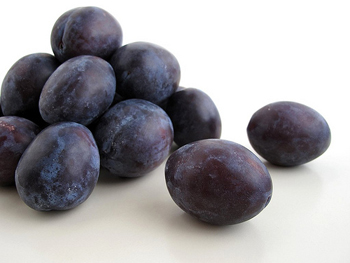 Plums are such a special fruit with so many uses. For me their flavor is most unique: they are sweet near the skin but tart by the pit. The color too is deeper toward the skin and paler near the pit. All stone fruits are spectacular, in my opinion, but I adore plums for this uniqueness. I love eating plums when they're so ripe that their juices squirt right out when you bite into them and run down your arm. That's when I find myself eating them over the kitchen sink. Often when I buy plums in bulk, instead of waiting for them to fully ripen, I usually end up making jam or baking them into pastries, pies, and tarts.
Plums are such a special fruit with so many uses. For me their flavor is most unique: they are sweet near the skin but tart by the pit. The color too is deeper toward the skin and paler near the pit. All stone fruits are spectacular, in my opinion, but I adore plums for this uniqueness. I love eating plums when they're so ripe that their juices squirt right out when you bite into them and run down your arm. That's when I find myself eating them over the kitchen sink. Often when I buy plums in bulk, instead of waiting for them to fully ripen, I usually end up making jam or baking them into pastries, pies, and tarts.
Late summer always rewards us with beautiful Italian prune plums, recognizable for their egg shape, dark and bluish exterior, and green to yellow interior. They are typically available from August until September and can be found widely in the States, but more so in Europe. Often they are dried to make prunes, but more famously are made into the eastern European liquor slivovitz. Plums have always been a favorite in my family. Many Hungarian recipes make use of them: one dish in particular is gomboc, which are plums encased in potato dumplings, and rolled in a cinnamon-breadcrumb mixture. I like them, but I love plums much more in pastries like this crostata.
 A crostata is a rustic Italian tart that is baked free-formed without being constrained to a pie or tart pan, much less a fluted one. It can be made with jelly, jam, pastry cream, and/or fresh fruit. Often when you bake a pie, the bottom crust ends up soggy. With a crostata, especially if you follow my technique, the bottom is crispy and crusty. My secret? I bake the crostata on a pizza stone. For ease of handling, I keep the tart on a baking sheet. I use a touch of cornmeal in the dough to give the crust a little crunch. The plums are tossed in sugar, lemon juice, Cognac, and potato starch. The Cognac heightens the fruitiness. The potato starch thickens the juices, which the plums emit so much of. I guarantee that this crostata won't hang around for long. Serve it warm with vanilla ice cream.
A crostata is a rustic Italian tart that is baked free-formed without being constrained to a pie or tart pan, much less a fluted one. It can be made with jelly, jam, pastry cream, and/or fresh fruit. Often when you bake a pie, the bottom crust ends up soggy. With a crostata, especially if you follow my technique, the bottom is crispy and crusty. My secret? I bake the crostata on a pizza stone. For ease of handling, I keep the tart on a baking sheet. I use a touch of cornmeal in the dough to give the crust a little crunch. The plums are tossed in sugar, lemon juice, Cognac, and potato starch. The Cognac heightens the fruitiness. The potato starch thickens the juices, which the plums emit so much of. I guarantee that this crostata won't hang around for long. Serve it warm with vanilla ice cream.
Plum Crostata
Note: For this recipe you want firm but slightly ripe plums, and preferably freestones, such as the Italian prune plums.
2 pounds firm ripe Italian prune plums, cut into sixths or eighths
1 tablespoon lemon juice
1 tablespoon Cognac
1 tablespoon potato starch
1/4 cup granulated sugar
1/4 teaspoon salt
Preheat oven with pizza stone to 400 degrees F.
Combine lemon juice, Cognac, potato starch, sugar, and salt; pour over plums. Toss carefully to coat. Let macerate for 10 minutes.
Roll out dough on a sheet of lightly floured parchment paper to 12 inches in diameter. Carefully lay dough with parchment paper on a baking sheet.
Pour plums and their juices onto the dough, spreading them out in an even layer and leaving a border around the edge. Fold up about a 1-1/2 to 2-inch border of dough, overlapping when necessary. Bake for 40 minutes until the plum juices are bubbling and the crust is golden brown. Let cool for at least 10 minutes before cutting and serving. Yield: 6 servings.
Crust
1 cup all-purpose flour
1/4 cup yellow cornmeal
1 tablespoon granulated sugar
1/4 teaspoon salt
1/2 cup (1 stick) unsalted butter, chilled, cut into small pieces
3 to 4 tablespoons ice water
In a large bowl, combine flour, cornmeal, sugar, and salt. Mix together with a whisk to aerate
Add butter and work with a pastry blender until mixture resembles course meal.
Add water 1 tablespoon at a time. Mix until dough comes together.
Form the dough into a flat disc and wrap in plastic. Chill for at least 1 hour before rolling.
Joseph Erdos is a New York–based writer and editor, butabove all a gastronomer and oenophile. He shares his passion for foodon his blog, Gastronomer's Guide , which features unique recipes and restaurant reviews among many other musings on the all-encompassing topic of food.

